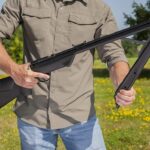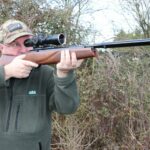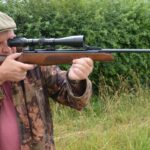PART I OF III: LEVER ACTION BALLISTICS
Not long ago, when Ranger Point was still building custom lever-action rifles, I spent time with each client on a discussion of ballistics. I may have disappeared down that particular rabbit hole a bit longer than anyone needs to, but the study of ballistics is more than an intellectual exercise. Whether you subscribe to the “one gun” approach or own one for every occasion, understanding cartridge ballistics will help you to make good choices and have the most rewarding experience with your firearm.
Ballistics discussions should revolve around the point of intended use, and explore the performance of cartridges under consideration, along with barrel length and its effects. It’s also a good idea to consider recoil, accuracy, ammunition availability, and the like. We’re going to do all that in our three part series on lever action ballistics.
Each part of the series will explore a different type of cartridge: The Big Bores, The Thirty-Somethings, and The Revolvers. We’ll focus mainly on modern chamberings, but touch upon some oldies too, since rifles and ammo can still be found.
In Part I, we look at the big bore, straight wall cartridge category, which includes the .444 Marlin, .45-70 Government, and .450 Marlin. These are some big, muscular brutes.
Since the .45-70 seems to be the king of lever cartridges, let’s start with it. This cartridge has had an incredible 150 year run, surviving near-extinction and more than one challenger to become wildly popular among modern lever-action shooters. The cartridge has an unassailable pedigree, but also more than a little murk and myth surrounding it.
First, let’s all please set aside the Hollywood legend of the Jurassic dino killer. When it comes to a discussion of the largest and most dangerous game, such as elephants, big cats, and cape buffalo, the .45-70 Govt is no king. Most cartridges designed to kill man-squishing animals are nearly twice as powerful.
And while the .45-70 was designed from the outset for long range killing, both its energy and range pale in comparison to modern sniper rounds like the .338 Lapua Mag. The Gov can absolutely kill at 1,000 yards, but it takes a very skilled shooter to guide those slow, arcing rounds to target.
What the big .45-70 does very well is penetrate, mostly by the physics of heavy, slow moving bullets. Like semi trucks, these boys will crush through a lot of barricades before stopping. The heaviest 500 grain pills will launch at barely supersonic speeds, but that won’t prevent them going from end to end in most large animals.
This ability to penetrate makes the .45-70 effective on a wide range of big, tough game. Certainly anything in North America, and yes, some African game too. But its penetration makes the Gov a very risky choice for self defense against human targets. Even mild loads can cause death and destruction long after the bullet has passed through a human target and several sheetrock walls.
Further detracting from any potential as a self defense cartridge, the .45-70 is painful to shoot. I mean painful to your shoulder, and painful to your wallet. A recent price check has the average price to $4/round. Even if you can manage the recoil, how much practice will you get at $80/box?
Let’s move off the Gov for now. Next in line is the cartridge that would be king, the .450 Marlin. The .450 Marlin, designed for and launched with Marlin’s 1895M rifle in the year 2000, was meant to supercede the .45-70 as Marlin’s heavy hitter. Confusion and disinterest ensued. Modern .45-70 loads were the equal of the .450, and Marlin was unable to make the case for its new bruiser, which slumped off like a defeated prize fighter.
Today, the under appreciated Marlin 1895M platform is the king of big bore value compared to its famous .45-70 brother. Not sold? Consider this: 1) The 1895 is actually the weakest receiver built on the 336 pattern. This is a fact, but it requires a longer explanation ( read a post with the facts here). 2) The 1895M was built specifically to address this weakness. I have personally observed and measured the improvements that made this possible.
Now we reach my personal favorite big bore, the mighty .444, aka triple 4, aka T4. Marlin introduced this impressively oversized .44 mag in 1964, when the .45-70 was nearly extinct. The .444 exceeded the performance of the Gov anyway, at that time, as factory .45-70 loads were still intended for the weaker Springfield Trapdoor rifles. The very powerful .45-70 loads we have now are a recent development.
The .444 reigned only briefly as the big bore lever action champ, but it remains popular today, thanks to its flexibility in dispatching all varieties of North American game. Factory ammo offerings are slim, but the .444 is a reloader’s dream, with a strong receiver and dozens of bullet types to choose from. Like it’s .45 cal brethren, the .444 is best applied where needed, rather than as a jack of all trades. It generates substantial recoil unless down loaded, and as of this writing ammo averaged $3.50/rnd.
We’ll wrap up this segment with a quick look at barrel length and its effect on big bore muzzle velocity. There is a powerful trend toward chopping barrels down to 18” or less these days, but it should be remembered that a significant performance sacrifice must be made. Most boxes of factory ammo list velocity through a 24” barrel, which already is longer than most lever guns.
As an example, Hornady lists a MV of 2,050 for its 325 FTX .45-70 round, which comes to about 3030ft/lbs of energy. By the time we reduce barrel length to 16”, we’ve lost about 170fps of velocity, along with nearly 500ft/lbs of energy, or about a 10mm auto pistol shot. Chopping the barrel to an SBR length of 12” brings velocity to about 1750fps, with energy now at about 2200ft/lbs, barely more than Hornady’s .30-30 LeveRevolution cartridge.
This velocity loss isn’t terrible compared to what happens with bottleneck cartridges, but it will be similar in the other big bores, and should give one pause before chopping. Additionally, muzzle blast and felt recoil increase as barrel length decreases, and of course, bullets drop much more rapidly down range, which places greater demand on the shooter’s skills.
The point is, buy or build the rifle that best suits your intended use. I find the big bores awesome, but I’m not afraid to admit that I shoot my .357 mag carbine about a hundred times more often. But if you absolutely, positively have to kill every bear in the room…















































